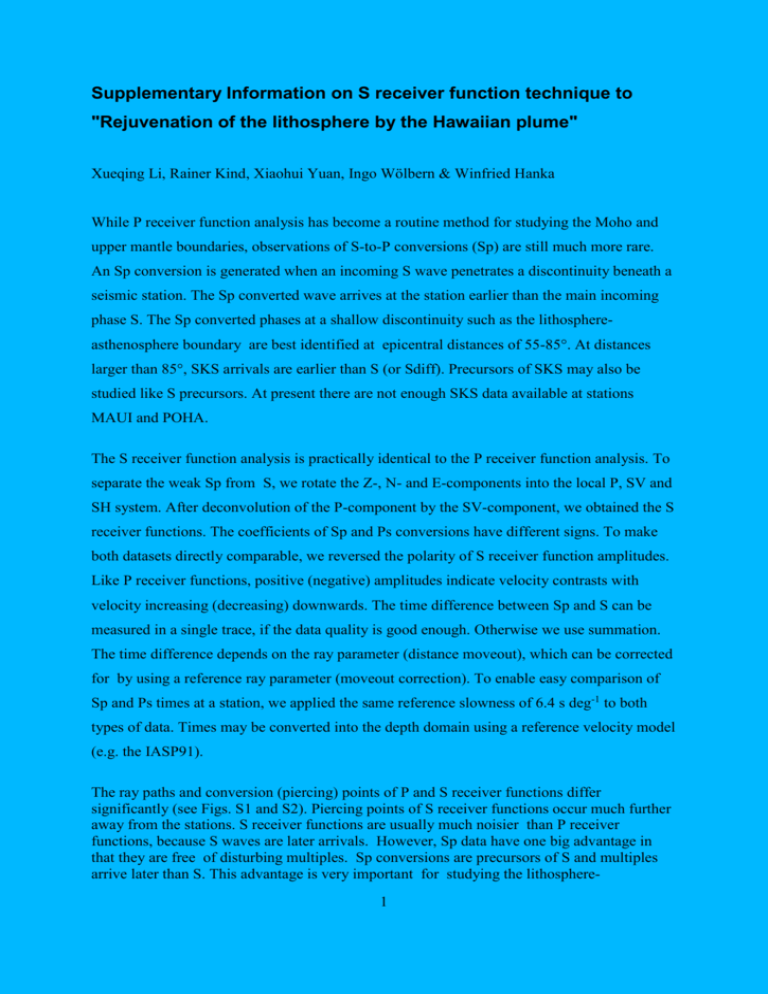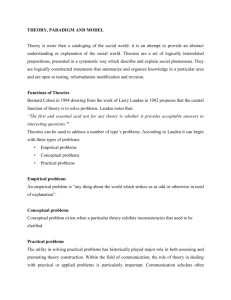Supplementary Information
advertisement

Supplementary Information on S receiver function technique to "Rejuvenation of the lithosphere by the Hawaiian plume" Xueqing Li, Rainer Kind, Xiaohui Yuan, Ingo Wölbern & Winfried Hanka While P receiver function analysis has become a routine method for studying the Moho and upper mantle boundaries, observations of S-to-P conversions (Sp) are still much more rare. An Sp conversion is generated when an incoming S wave penetrates a discontinuity beneath a seismic station. The Sp converted wave arrives at the station earlier than the main incoming phase S. The Sp converted phases at a shallow discontinuity such as the lithosphereasthenosphere boundary are best identified at epicentral distances of 55-85°. At distances larger than 85°, SKS arrivals are earlier than S (or Sdiff). Precursors of SKS may also be studied like S precursors. At present there are not enough SKS data available at stations MAUI and POHA. The S receiver function analysis is practically identical to the P receiver function analysis. To separate the weak Sp from S, we rotate the Z-, N- and E-components into the local P, SV and SH system. After deconvolution of the P-component by the SV-component, we obtained the S receiver functions. The coefficients of Sp and Ps conversions have different signs. To make both datasets directly comparable, we reversed the polarity of S receiver function amplitudes. Like P receiver functions, positive (negative) amplitudes indicate velocity contrasts with velocity increasing (decreasing) downwards. The time difference between Sp and S can be measured in a single trace, if the data quality is good enough. Otherwise we use summation. The time difference depends on the ray parameter (distance moveout), which can be corrected for by using a reference ray parameter (moveout correction). To enable easy comparison of Sp and Ps times at a station, we applied the same reference slowness of 6.4 s deg-1 to both types of data. Times may be converted into the depth domain using a reference velocity model (e.g. the IASP91). The ray paths and conversion (piercing) points of P and S receiver functions differ significantly (see Figs. S1 and S2). Piercing points of S receiver functions occur much further away from the stations. S receiver functions are usually much noisier than P receiver functions, because S waves are later arrivals. However, Sp data have one big advantage in that they are free of disturbing multiples. Sp conversions are precursors of S and multiples arrive later than S. This advantage is very important for studying the lithosphere1 asthenosphere boundary, since this boundary is almost invisible in P receiver functions due to crustal multiples arriving at nearly the same time. Moveout corrected Sp and Ps data of each Hawaiian station are stacked and shown in Fig. S3. The S receiver functions are plotted in reversed time to make them directly comparable with the P receiver functions. A closely correlated negative phase (velocity reduction downwards) is marked in the S and P receiver function traces at each station and is interpreted as the lithosphere-asthenosphere boundary. Because of different locations of the piercing points and interference with the crustal multiples in the P receiver functions, the marked phases are not completely identical.Figures Fig. S1: Ray paths of P and S receiver functions. 2 Fig. S2: Location map of piercing points of P (blue circles) and S (red crosses) receiver functions at 100 km depth for each of the three broadband stations, showing the sampling regions of the two kinds of data. 3 Fig. S3: Summation of P (blue) and S (red) receiver functions at each station. Moveout corrections are made for a reference slowness of 6.4 s deg-1. Time scale, as well as the polarity of amplitudes of the S receiver functions is reversed in order to be directly comparable with the P receiver functions. The large amplitudes of S receiver functions at time 0 s are remaining S wave energy resulted from imperfect coordinate rotation. The S waves, as well as the multiple phases, appear at later time and therefore do not interfere the Sp conversions. Arrows mark the average time of conversion from the lithosphere-asthenosphere boundary. Both types of receiver function agree reasonably well, considering the different locations of their piercing points. 4






